- Publisher's Note
- Editorial
- Jogen Chowdhury: Maestro par Excellence
- Company School Paintings of Calcutta, Murshidabad, Patna (1750-1850): Doctoral Thesis of Late Dipak Bhattacharya (1960-2007)
- Kalighat Pat, a Protomodern Art Tradition?
- Academic Naturalism in Art of Bengal: The First Phase of Modernity
- Under the Banyan Tree - The Woodcut Prints of 19th Century Calcutta
- The Arabian Nights and the Web of Stories
- Gaganendranath Tagore's Satirical Drawings and Caricatures
- Gaganendranath's Moments with Cubism: Anxiety of Influence
- Abanindranath as Teacher: Many Moods, Some Recollections
- Atul Bose: A Short Evaluation
- J.P. Gangooly: Landscapes on Canvas
- Defined by Absence: Hemen Majumdar's Women
- Indra Dugar: A Profile of a Painter
- The Discreet Charm of Fluid Lines!
- Delightful Dots and Dazzling Environments: Kusama's Obsessive Neurosis
- Peaceful be Your Return O Lovely Bird, from Warm Lands Back to My Window
- Shunya: A Beginning from a Point of Neutrality
- The Tagore Phenomenon, Revisited
- The Bowl, Flat and Dynamic Architecture of the BMW Museum
- Baccarat Paperweights: Handmade to Perfection
- Byzantium and Islam: Age of Transition at the Metropolitan Museum of Art
- Outstanding Egyptian Art at the Metropolitan Museum of Art
- Retrospective of Wu Guanzhong at the Asia Society Museum
- Masterpieces from India's Late Mughal Period at the Asia Society Museum
- The Dhaka Art Summit: Emergence of Experimental Art Forms
- Many Moods of Eberhard Havekost
- Random Strokes
- Is it Putin or the Whole Russian State?
- The Onus Lies With Young India
- What Happened and What's Forthcoming
- Preview May, 2012 – June, 2012
- In the News, May 2012
- Art Events Kolkata, April – May 2012
- Mumbai Art Sighting
- Delhi Dias
- Art Bengaluru
- Musings from Chennai
- Cover
ART news & views
Kalighat Pat, a Protomodern Art Tradition?
Issue No: 29 Month: 6 Year: 2012
by Pranabranjan Ray
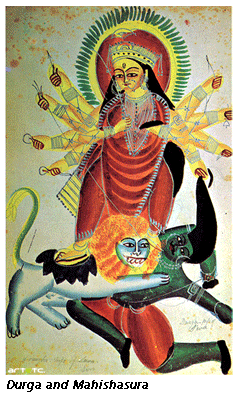 Owing to the waning of the late medieval rural patronage system, resulting from the introduction of new land tenurial arrangement under the Permanent Settlement of 1793 and the Cornwallis Code, the rural crafts lost their demand in the rural areas of the then Bengal and the craftsmen were in disarray. At the same time, colonial trade was leading to the growth of port-centric urban metropolis like Calcutta, especially from the last decade of the eighteenth century. Needless to say, various kinds of compradors or native collaborators of colonial trade were the earliest wealth accumulating settlers of the city, they were soon followed by absentee landlords of rural hinterland -created by the Permanent Settlement. Some from among both the groups soon became the first set of real-estate owners and urban rentiers in the growing metropolis of colonial expropriation. But they were not the only early settlers of the metropolis. The colonial trade as well as the need of durable asset building of the native settlers necessitated the presence of army of skilled and unskilled wage labourers. Although many of them remained seasonal immigrants from rural areas around, some of them, at least the skilled ones became the lower-rung citizens of the metropolis. The skilled artisans who were immigrating into the city in search of secure employment, needed to adapt their skills to cater to new demands of the neo-urbanites. They had to learn cognate skills to tackle new materials and methods. Artisans skilled in carving and engraving, were learning print-taking on paper for making themselves worthy of newly grown printing and publishing industry.
Owing to the waning of the late medieval rural patronage system, resulting from the introduction of new land tenurial arrangement under the Permanent Settlement of 1793 and the Cornwallis Code, the rural crafts lost their demand in the rural areas of the then Bengal and the craftsmen were in disarray. At the same time, colonial trade was leading to the growth of port-centric urban metropolis like Calcutta, especially from the last decade of the eighteenth century. Needless to say, various kinds of compradors or native collaborators of colonial trade were the earliest wealth accumulating settlers of the city, they were soon followed by absentee landlords of rural hinterland -created by the Permanent Settlement. Some from among both the groups soon became the first set of real-estate owners and urban rentiers in the growing metropolis of colonial expropriation. But they were not the only early settlers of the metropolis. The colonial trade as well as the need of durable asset building of the native settlers necessitated the presence of army of skilled and unskilled wage labourers. Although many of them remained seasonal immigrants from rural areas around, some of them, at least the skilled ones became the lower-rung citizens of the metropolis. The skilled artisans who were immigrating into the city in search of secure employment, needed to adapt their skills to cater to new demands of the neo-urbanites. They had to learn cognate skills to tackle new materials and methods. Artisans skilled in carving and engraving, were learning print-taking on paper for making themselves worthy of newly grown printing and publishing industry.
Historically, the genesis, growth and decay of Kalighat pat painting tradition, need to be viewed in this perspective. The history of the school of art, however, is a poor index of its artistic significance. Yet, the aesthetic worth of the Kalighat pat painting increases with the knowledge of its history. The history, however, is largely conjectural as very few of the paintings, by themselves, can hardly be used as documents in evidence.
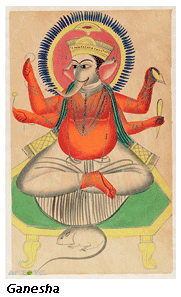
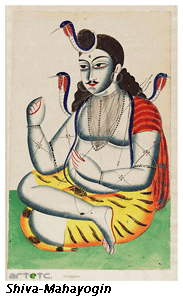
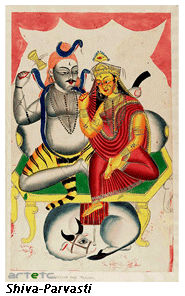
It seems that groups of Hindu clay-idol makers and pat painters, belonging mainly to kumbhakar and sutradhar castes (and not to the chitrakar caste - a group ocilating between folkish-Hinduism and Islam), emigrated from Midnapore, and settled down in what was to become the patuapara neighbourhood in the Kalighat region of south Calcutta, in the beginning of the nineteenth century. The push-factor in their emigration from rural areas, needless to say, was waning of patronage. The pull factor - ipso facto was not urban situation, but the streams of pilgrim to the Kali-temple of Kalighat who would inevitably buy some cheap souvenirs from the market surrounding the temple while returning, Calcutta's rapid urbanization from the beginning of the nineteenth century not only led to greater volume of pilgrim visits from hinterland but also frequent visits by Hindu Calcuttans. The increased demand for souvenirs was the prime incentive for the immigrant idol makers and pata painters. Anticipating popular demand they started producing miniature clay idols and painted iconic images of popular Hindu gods and goddesses (mainly of Sakta and Saiva sects). By the second decade of the nineteenth century the Kalighat patuas were turning over hundreds of these cheap paintings on paper per week to be picked up by pilgrims
 The necessity of producing painting in bulk and that too at quick pace led the Kalighat patuas to adapt a big technological change, a change from that followed by the rural pata painters traditionally. The Kalighat painters shifted to manufactured paper as support, from cloth and/or handmade paper pasted on cloth that the rural patuas did. Secondly, instead of vegetable and mineral pigments tempered by vegetable glue that the rural patuas used, the Kalighat patuas started using manufactured water-colours (sometimes mixed with opaque whites) and inks (mainly for contour lines).In that too the Kalighat patuas would use improvised brushes with bristles, instead of various kinds of cloth dabbers. The technological change, necessitated by quick production in bulk, calling for less labour intensive process, and availability manufactured material inputs led to a unthought of visualinguistic and stylistic disjuncture in the Bengal pat painting tradition. But whatever, by way of change in materials and methods, went into the making of the Kalighat pat painting were not, at least to start with, resultant of any conscious choice.
The necessity of producing painting in bulk and that too at quick pace led the Kalighat patuas to adapt a big technological change, a change from that followed by the rural pata painters traditionally. The Kalighat painters shifted to manufactured paper as support, from cloth and/or handmade paper pasted on cloth that the rural patuas did. Secondly, instead of vegetable and mineral pigments tempered by vegetable glue that the rural patuas used, the Kalighat patuas started using manufactured water-colours (sometimes mixed with opaque whites) and inks (mainly for contour lines).In that too the Kalighat patuas would use improvised brushes with bristles, instead of various kinds of cloth dabbers. The technological change, necessitated by quick production in bulk, calling for less labour intensive process, and availability manufactured material inputs led to a unthought of visualinguistic and stylistic disjuncture in the Bengal pat painting tradition. But whatever, by way of change in materials and methods, went into the making of the Kalighat pat painting were not, at least to start with, resultant of any conscious choice.
Let us, then, make a list of the disjunctive visualinguistic elements, resulting from change in art technology, that characterize the Kalighat pat paintings distinctively.
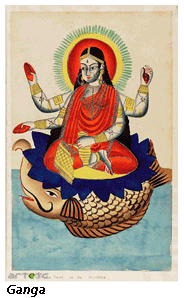

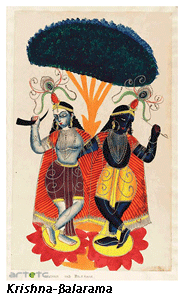
First, let us deal with the representation of idols of gods and goddesses, like Kali in her various manifestations and Siva - her consort - in various situations, which formed the three-fourth of all Kalighat pats, painted between the first decades of the nineteenth and the first decades of the twentieth century (the one-hundred year life span of the school). Single, almost the whole sheet covering icon - in all its codified iconographic attributes - would occupy the larger part of the pictorial space. The image would be defined by concavilinear and convexilinear parabolically flowing contour lines, denying any anatomical connotation. The innards of the figures would either be coloured flatly or have no colour, denying illusionistic representation of bodily volume. Whatever suggestion of bodily volume there would be, would be the resultant effect of juxtaposition of the convexilinear and concavilinear modeled line. As these extremely linearly and flatly rendered figures would be posited singly on flat surface, without any suggestion of any image elsewhere in the pictorial space, there would not be any illusion-producing visual element in the painting, consequently the painting would be two-dimensional image on a flat surface, so dearly valued by the Modernists.


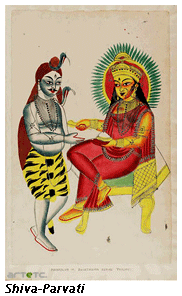
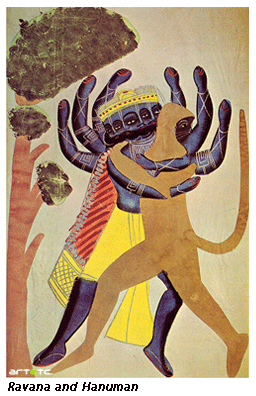 However, of more art-historical importance, are the paintings with secular non-ritualistic subject matter. Although these did not, in all probability, constitute more than one-third of the total bulk of all Kalighat pats, these were something that represented the mentality, the attitude of the makers. In these they revealed themselves to be more than just caterers of ritual objects. They were artists with mind. These immigrants into the colonial expropriative city were critical of the behavioral immorality and debauchery of the new urban nuveau riche and leisured wealth earners and priestly classes dependent on the former. Through visual narratives of contemporary events and metaphorical representation of human follies by surrogating human images by the imagery of beings like cats and fishes etc., the artists objectified their attitudes and mentality. Visualinguistically these were of the same genre as the iconic pictures, but to the artists their compositions posed greater syntactical problems which they solved with consummate artistry. As in these, they had to configurate more than one figurative and other images, on flat two-dimensional surface without taking recourse of any illusionistic strategy like three-dimensional perspective and relative proportional size-variation etc., they faced the formidable task of integrating a painting. This they achieved by carrying the rhythm, of the parabolically flowing curvilinear lines which contoured each image, continuously through the whole compositions. A remarkably painterly strategy. There is the internal evidence of the Tarakeswar Mahanta and Elokeshi event, on which scores of pats were drawn in Kalighat, that these secular pats could not have been painted before the second-half of the nineteenth century. Form the quality of paper and the relatively large size of some of these pats, it seems that many of these were painted on commission from connoisseurs like Justice John Woodroff (who translated and edited Sanskrit texts on Tantra under the pseudonym Arthur Avalon), the civilian W.G. Archer and Senior Thomas Bata, whose collections are to be found now in the Victoria and Albert Museum, London, the Bodlian Library, Oxford and the Charles University Museum, Prague.
However, of more art-historical importance, are the paintings with secular non-ritualistic subject matter. Although these did not, in all probability, constitute more than one-third of the total bulk of all Kalighat pats, these were something that represented the mentality, the attitude of the makers. In these they revealed themselves to be more than just caterers of ritual objects. They were artists with mind. These immigrants into the colonial expropriative city were critical of the behavioral immorality and debauchery of the new urban nuveau riche and leisured wealth earners and priestly classes dependent on the former. Through visual narratives of contemporary events and metaphorical representation of human follies by surrogating human images by the imagery of beings like cats and fishes etc., the artists objectified their attitudes and mentality. Visualinguistically these were of the same genre as the iconic pictures, but to the artists their compositions posed greater syntactical problems which they solved with consummate artistry. As in these, they had to configurate more than one figurative and other images, on flat two-dimensional surface without taking recourse of any illusionistic strategy like three-dimensional perspective and relative proportional size-variation etc., they faced the formidable task of integrating a painting. This they achieved by carrying the rhythm, of the parabolically flowing curvilinear lines which contoured each image, continuously through the whole compositions. A remarkably painterly strategy. There is the internal evidence of the Tarakeswar Mahanta and Elokeshi event, on which scores of pats were drawn in Kalighat, that these secular pats could not have been painted before the second-half of the nineteenth century. Form the quality of paper and the relatively large size of some of these pats, it seems that many of these were painted on commission from connoisseurs like Justice John Woodroff (who translated and edited Sanskrit texts on Tantra under the pseudonym Arthur Avalon), the civilian W.G. Archer and Senior Thomas Bata, whose collections are to be found now in the Victoria and Albert Museum, London, the Bodlian Library, Oxford and the Charles University Museum, Prague.
With the growth, first of manual printmaking through wood block printing and lithography, and then from the second decade of the twentieth century - through mechanical reproduction, the demand for hand painted pats were declining rapidly. And by the early thirties the demand dried up completely, leading to the demise of the hundred year old Kalighat pat tradition.
Kalighat pat tradition, howsoever it may have differed from the traditional pata painting of rural Bengal, did not lead to the emergence of the self-conscious individual artist, with personal thematic and stylistic concerns. The thematic and visualinguistic concern of the Kalighat patuas, till the end, remained under community hegemony, so much so that the patuas would endlessly go on producing similar images in similar style. The Kalighat tradition of pat painting can at best be assigned its place in the history of Indian art as comprising a school of proto-history of modern Indian art.
The protomodern visualinguistics (as detailed earlier in this article) of the Kalighat pat, impressed the modern Bengal individualist artists like the post-1925 Jamini Roy, Sunayani Devi in the thirties and forties, Nandalal Bose of the Haripura Congress posters, Abanindranath of his Chandimangal and Krishnamangal serieses, Nirode Mazumdar and Paritosh Sen so much, that they appropriated and adapted elements from the Kalighat pat tradition and saved their art from being derivative of Euro-genetic Modernist art and/or revivalist Indian art.